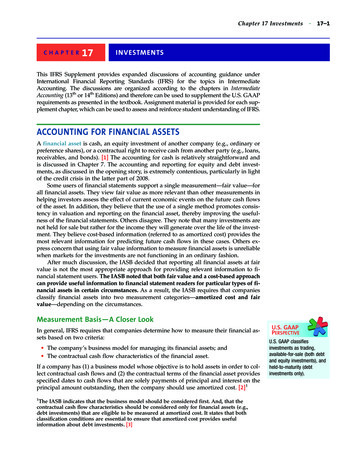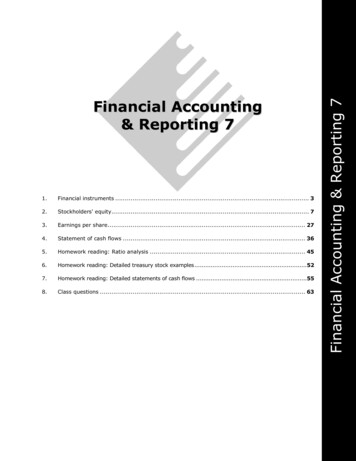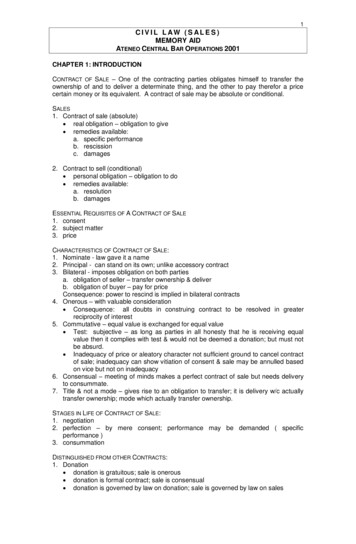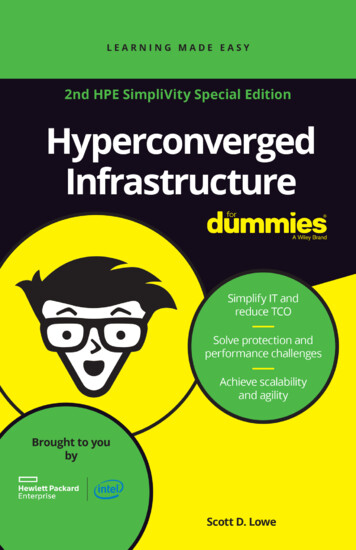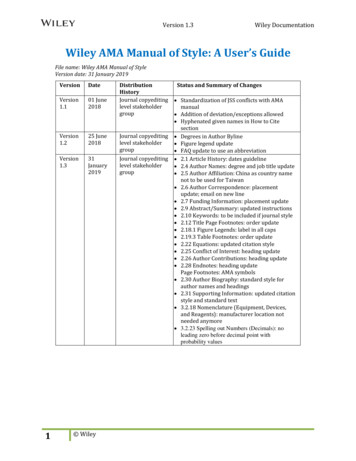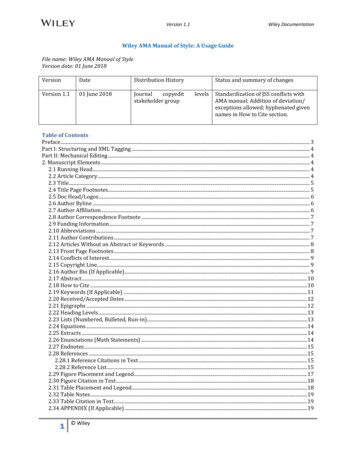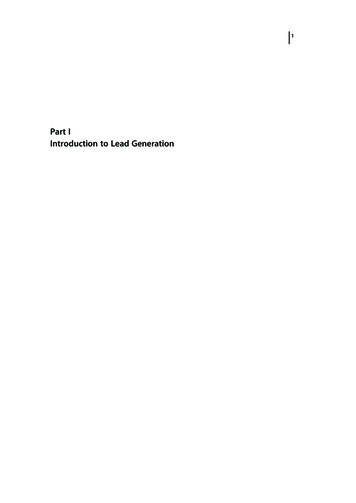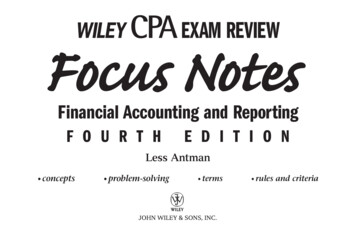
Transcription
WILEY CPA EXAM REVIEWFinancial Accounting and ReportingF O U R T HE D I T I O NLess Antman concepts problem-solving terms rulesand criteria
WILEY CPA EXAM REVIEWFinancial Accounting and ReportingF O U R T HE D I T I O NLess Antman concepts problem-solving terms rulesand criteria
Copyright 2006, by John Wiley & Sons, Inc. All rights reserved.Published by John Wiley & Sons, Inc., Hoboken, New JerseyPublished simultaneously in Canada.No part of this publication may be reproduced, stored in a retrieval system or transmitted in any form or by anymeans, electronic, mechanical, photocopying, recording, scanning or otherwise, except as permitted underSection 107 or 108 of the 1976 United States Copyright Act, without either the prior written permission of thePublisher, or authorization through payment of the appropriate per-copy fee to the Copyright Clearance Center,Inc., 222 Rosewood Drive, Danvers, MA 01923, 978-750-8400, fax 978-750-4470, or on the Web atwww.copyright.com. Requests to the Publisher for permission should be addressed to the PermissionsDepartment, John Wiley & Sons, Inc., 111 River Street, Hoboken, NJ 07030, 201-748-6011, fax 201-748-6008,or online at http://wiley.com/go/permission.Limit of Liability/Disclaimer of Warranty: While the publisher and author have used their best efforts in preparingthis book, they make no representations or warranties with respect to the accuracy or completeness of thecontents of this book and specifically disclaim any implied warranties of merchantability or fitness for aparticular purpose. No warranty may be created or extended by sales representatives or written salesmaterials. The advice and strategies contained herein may not be suitable for your situation. You shouldconsult with a professional where appropriate. Neither the publisher nor author shall be liable for any loss ofprofit or any other commercial damages, including but not limited to special, incidental, consequential, or otherdamages.ISBN 13: 978-0471-78440-1ISBN 0-471-78440-0Printed in the United States of America10 9 8 7 6 5 4 3 2 1
ContentsBasic Theory & Financial Reporting . 1Inventory . 26Fixed Assets . 49Monetary Current Assets & Current Liabilities. 72Present Value . 95Deferred Taxes . 127Stockholders’ Equity . 133Investments . 158Statement of Cash Flows. 166Business Combinations & Consolidations . 174Derivative Instruments & Hedging Activities. 184Miscellaneous . 188Governmental . 209Not-For-Profit . 251Index . 263
PrefaceThis publication is a comprehensive, yet simplified study program. It provides a review of all thebasic skills and concepts tested on the CPA exam, and teaches important strategies to take theexam faster and more accurately. This tool allows you to take control of the CPA exam.This simplified and focused approach to studying for the CPA exam can be used: As a handy and convenient reference manual To solve exam questions To reinforce material being studiedIncluded is all of the information necessary to obtain a passing score on the CPA exam in aconcise and easy-to-use format. Due to the wide variety of information covered on the exam, anumber of techniques are included: Acronyms and mnemonics to help candidates learn and remember a variety of rules andchecklists Formulas and equations that simplify complex calculations required on the exam
Simplified outlines of key concepts without the details that encumber or distract fromlearning the essential elements Techniques that can be applied to problem solving or essay writing, such as preparing amultiple-step income statement, determining who will prevail in a legal conflict, ordeveloping an audit program Pro forma statements, reports, and schedules that make it easy to prepare these itemsby simply filling in the blanks Proven techniques to help you become a smarter, sharper, and more accurate test takerThis publication may also be useful to university students enrolled in Intermediate, Advancedand Cost Accounting, Auditing, Business Law, and Federal Income Tax classes.Good Luck on the Exam,Less Antman, CPA
About the AuthorLess Antman, CPA has been preparing individuals for the CPA exam since 1979. For manyyears, he taught CPA review classes on a full-time basis for various programs, including Mark’sCPA Review Course and Kaplan CPA Review. He currently operates his own CPA reviewprogram in the state of California, under the name Antman CPA Review, located in Arcadia,California. He has taught more than 5,000 totally live CPA review classes, more than any otherCPA review instructor in the United States, and his written materials have been used in severaldifferent instructor-based CPA review programs.
Objectives of Financial ReportingFinancial statements are designed to meet the objectives of financial reporting:Balance SheetDirect InformationFinancial PositionStatement of Earnings andComprehensive IncomeDirect InformationEntity PerformanceStatement of Cash FlowsDirect InformationEntity Cash FlowsFinancial Statements TakenAs a WholeIndirect InformationManagement & PerformanceFocus onBasic Concepts - Module 71
Qualitative Characteristics of Accounting InformationUsefulnessPrimary ictive valueRepresentational faithfulnessFeedback econdary QualitativeCharacteristicsConsistency& ComparabilityFocus onBasic Concepts - Module 72
Elements of Financial StatementsAssets Liabilities EquityEquity Contributionsby ownersComprehensiveIncomeDistributionsto owners Revenues ComprehensiveIncomeExpenses GainsLossesComprehensive Income Net income Adjustments to stockholders’ equityFocus onBasic Concepts - Module 73
Basic Rules & ionAllocationMatchingFull disclosureYou’ll get more credit (CR) if you CRAM your essays FULL ofthese rules and conceptsFocus onBasic Concepts - Module 74
Revenue RecognitionAccrual methodCollection reasonably assuredDegree of uncollectibility estimableInstallment saleCollection not reasonably assuredCost recoveryCollection not reasonably assuredNo basis for determining whether or not collectibleInstallment Sales MethodInstallment receivable balance Gross profit percentage Deferred gross profit (balance sheet)Cash collections Gross profit percentage Realized gross profit (income statement)Cost Recovery MethodAll collections applied to cost before any profit or interest income is recognizedFocus onBasic Concepts – Module 75
Converting from Cash Basis to Accrual BasisRevenuesCash (amount received)Increase in accounts receivable (given)Decrease in accounts receivable (given)Revenues (plug)xxxxxxxxCost of SalesCost of sales (plug)Increase in inventory (given)Decrease in accounts payable (given)Decrease in inventory (given)Increase in accounts payable (given)Cash (payments for merchandise)xxxxxxxxxxxxFocus onBasic Concepts – Module 76
ExpensesExpense (plug)Increase in prepaid expenses (given)Decrease in accrued expenses (given)Decrease in prepaid expenses (given)Increase in accrued expenses (given)Cash (amount paid for expense)xxxxxxxxxxxxBalance SheetCurrent AssetsCashTrading securitiesCurrent securities available for saleAccounts receivableInventoriesPrepaid expensesCurrent deferred tax assetCurrent LiabilitiesShort-term debtAccounts payableAccrued expensesCurrent income taxes payableCurrent deferred tax liabilityCurrent portion of long-term debtUnearned revenuesFocus onBasic Concepts – Module 77
Long-Term InvestmentsNoncurrent securities available for saleSecurities held to maturityInvestments at cost or equityLong-Term DebtLong-term notes payableBonds payableNoncurrent deferred tax liabilityProperty, Plant, & EquipmentIntangiblesOther AssetsDepositsDeferred chargesNoncurrent deferred tax assetStockholders’ EquityPreferred stockCommon stockAdditional paid-in capitalRetained earningsAccumulated other comprehensive incomeFocus onFinancial Statements – Module 78
Current Assets & LiabilitiesAssetsEconomic resourceFuture benefitControl of companyPast event or transactionLiabilitiesEconomic obligationFuture sacrificeBeyond control of companyPast event or transactionCurrent AssetsConverted into cash or used upLonger of:One yearOne accounting cycleCurrent LiabilitiesPaid or settledLonger of:One yearOne accounting cycleOR Requires use of current assetsFocus onFinancial Statements – Module 79
Special DisclosuresSignificant Accounting PoliciesInventory methodDepreciation methodCriteria for classifying investmentsMethod of accounting for long-term construction contractsRelated-Party TransactionsExceptions:SalaryExpense reimbursementsOrdinary transactionsFocus onFinancial Statements – Module 710
Reporting the Results of OperationsPreparing an Income StatementMultiple stepRevenues– Cost of sales Gross profit– Operating expensesSelling expensesG & A expenses Operating income Other income Gains– Other expenses– Losses Income before taxes– Income tax expense Income from continuing operationsSingle stepRevenues Other income Gains Total revenues– Costs and expensesCost of salesSelling expensesG & A expensesOther expensesLossesIncome tax expense Income from continuing operationsFocus onFinancial Statements – Module 711
Computing Net IncomeIncome from continuing operations (either approach) Discontinued operations Extraordinary items Net income(Cumulative changes section was eliminated by SFAS 154)Focus onFinancial Statements – Module 712
Errors Affecting IncomeError (ending balance)Current stmtPrior stmtAsset overstatedOverstatedNo effectAsset understatedUnderstatedNo effectLiability overstatedUnderstatedNo effectLiability understatedOverstatedNo effectError (beginning balance – ending balance is correct)Asset overstatedUnderstatedOverstatedAsset understatedOverstatedUnderstatedLiability overstatedOverstatedUnderstatedLiability understatedUnderstatedOverstatedFocus onFinancial Statements – Module 713
Errors Affecting Income (continued)Error (beginning balance – ending balance is not correct)Asset overstatedNo effectOverstatedAsset understatedNo effectUnderstatedLiability overstatedNo effectUnderstatedLiability understatedNo effectOverstatedFocus onFinancial Statements – Module 714
Extraordinary ItemsClassification as extraordinary – 2 requirements (both must apply) Unusual in nature Infrequent of occurrenceOne or neither applies – component of income from continuing operationsExtraordinaryNegative goodwill on consolidation resulted from purchase (always)Acts of nature (usually)Not ExtraordinaryGains or losses on sales of investments or prop, plant, & equipGains or losses due to changes in foreign currency exchange ratesWrite-offs of inventory or receivablesEffects of major strikes or changes in value of investmentsFocus onFinancial Statements – Module 715
Change in Accounting PrincipleUse retrospective application of new principle:1) Calculate revised balance of asset or liability as of beginning of period as if new principlehad always been in use.2) Compare balance to amount reported under old method3) Multiply difference by 100% minus tax rate4) Result is treated on books as prior period adjustment to beginning retained earnings .5) All previous periods being presented in comparative statements restated to new principle.6) Beginning balance of earliest presented statement of retained earnings adjusted for alleffects going back before that date.Focus onFinancial Statements – Module 716
Change in Accounting Principle (continued)Journal entry:Asset or liabilityRetained earningsCurrent or deferred tax liability (asset)xxxxxxxxxOrRetained earningsCurrent or deferred tax liability (asset)Asset or liabilityxxxxxxxxxFocus onFinancial Statements – Module 717
Special ChangesChanges in accounting principle are handled using the prospective method under limitedcircumstances. No calculation is made of prior period effects and the new principle is simplyapplied starting at the beginning of the current year when the following changes in principleoccur: Changes in the method of depreciation, amortization, or depletionChanges whose effect on prior periods is impractical to determine (e.g. changes to LIFOwhen records don’t allow computation of earlier LIFO cost bases)(Note: the method of handling changes in accounting principle described here under SFAS 154replaces earlier approaches, which applied the cumulative method to most changes inaccounting principle. SFAS 154 abolished the use of the cumulative method.)Focus onFinancial Statements – Module 718
Change in Estimate No retrospective applicationChange applied as of beginning of current periodApplied in current and future periodsFocus onFinancial Statements – Module 719
Error CorrectionsApplies to: Change from unacceptable principle to acceptable principleErrors in prior period financial statementsWhen error occurred:Prior periods( Not presented )Prior periodAdjustment( Beginning ret. earn.)Pri
Less Antman, CPA has been preparing individuals for the CPA exam since 1979. For many years, he taught CPA review classes on a full-time basis for various programs, including . Mark’s CPA Review Course and Kaplan CPA Review. He currently operates his own CPA review program in the state of California, under the name . Antman CPA Review,
